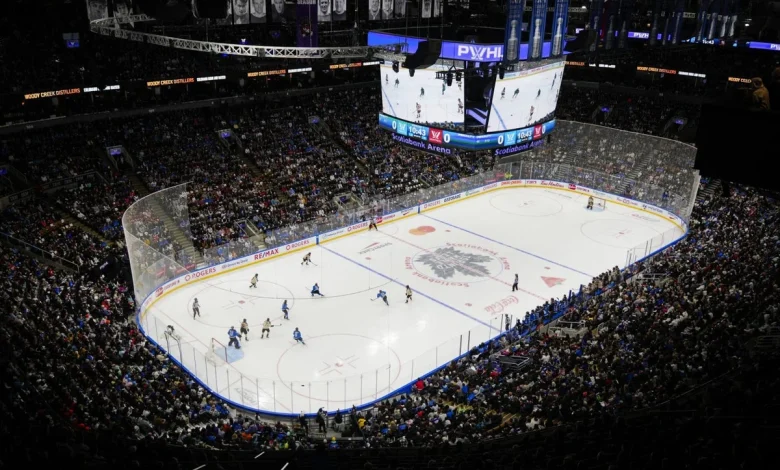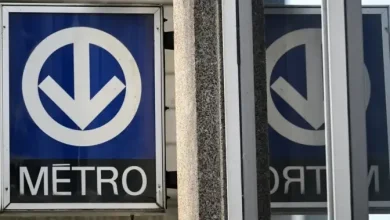Why Toronto is a top women’s sports city (despite The Athletic’s snub)

What if I told you there’s a city that broke the all-time attendance record for a women’s hockey game, was awarded a WNBA expansion franchise and has produced dozens of Olympic medalists?
And what if I told you that city, Toronto, did not make The Athletic’s top 10 list of the best women’s sports cities?
The response from many Torontonians — maybe even many Canadians — might be similar to Toronto native and two-time Olympic gold medalist Natalie Spooner’s own reaction.
“I’m shocked,” said Spooner, who grew up in Scarborough, Ont., and is now a forward for the Toronto Sceptres in the Professional Women’s Hockey League. “Even just the community that fans have built around our team. … That alone shows how great of a women’s sports community there is in Toronto and how it should be in the top 10.”
Let’s start with the obvious: the Toronto Sceptres, and the team’s success since the PWHL launched in January 2024.
Toronto sold out every home game of its inaugural season, with season ticket packages and single-game tickets selling out within minutes. Yes, the team was playing at the far-too-small 2,600-seat Mattamy Athletic Centre, but the demand was real.
When the league moved a February 2024 game between Toronto and Montreal to a much larger venue, Scotiabank Area, home of the NHL’s Toronto Maple Leafs, tickets sold out within minutes of the start of the general on-sale.
“It’s just sort of the perfect storm of perfect market, perfect match-up, a beautiful building, and Mattamy is sold out, so this is really the one time you’re going to be able to see them play during the season,” Amy Scheer, the league’s executive vice president of business operations, said at the time.
The draw of 19,285 fans at Scotiabank Arena became the largest crowd to watch women’s hockey ever, including the Olympics, world championships and the NCAA. The record fell a few months later to Montreal at the Bell Centre, but that February game was proof of concept that there’s an audience for women’s professional hockey — in general but also specifically in Toronto.
“Obviously coming out, being from Toronto and just hearing how loud it was in there, was pretty crazy,” said Spooner. “It was such a cool atmosphere to be able to play in when there’s that many people. The fans were loud, and they were excited to be there.”
Ahead of Season 2, the PWHL moved its Toronto franchise to Coca-Cola Coliseum, which seats over 8,000 fans — a significant upgrade from 2,600 at Mattamy the year before. It was a big and natural next step for the Toronto franchise, which was among the top teams in the league by home attendance in the regular season.
But it’s more than just the sheer number of fans who have attended Toronto games in the city. If we’re measuring on vibes, those are pretty unmatched at Sceptres games, too. It’s a positive, communal hockey-watching experience — something that can be in short supply in this city. Toronto Maple Leafs games are often a tense, sometimes toxic, or at the very least silent, experience. That’s not the way it is when the Sceptres are playing.
You see little kids, older women, a vibrant queer community, families and more coming together to rally behind the team. There are super fans, like Debbie Harris, the 64-year-old who got Crayola Canada to make a new purple crayon for the PWHL in 2024. And Connie Hamers, who’s become known in the rink for her “Emma Nation,” section after taking a liking to Sceptres and Team Canada star Emma Maltais.
This is awesome.
Crayola Canada is releasing a new colour, powerplay plum, in honour of the PWHL and Toronto super fan Debbie Harrison.
Harrison wore this to one of Toronto’s first games. pic.twitter.com/2pl9DzERgF
— Mark Colley (@MarkColley) March 12, 2024
There’s less baggage and more positivity when the Sceptres are on the ice. And for a city that has come to define itself partially by hockey heartbreak and futility, the fact that Sceptres games are such a positive experience is notable.
“Fans have built a community here,” said Spooner. “They want to be involved, they want to feel part of the team, and I think that’s pretty special.”
The pipeline of talent from the Greater Toronto Area also can’t be ignored. There’s Spooner, who won PWHL MVP in 2024 for her hometown team. Sarah Fillier, who tied for the league in scoring last season for the New York Sirens, grew up 30 miles outside the city. If we consider Hamilton part of the larger Toronto-Horshoe area, Sarah Nurse is one of the biggest faces in the sport.
Eight players on Team Canada’s 2022 Olympic gold medal winning hockey team are from the GTA – nine if we include Nurse.
Let’s not forget about the history either. Angela James, one of the sport’s original stars, grew up in Toronto and became one of the first women inducted into the Hockey Hall of Fame in 2010. Geraldine Heaney, who is also in the Hall, grew up in North York, and led Canada to seven-straight world championships in the ’90s.
Now, there’s an impulse to pigeon hole Toronto as all hockey, all the time. It’s understandable. And even if that were true, if Kansas City deserves credit for supporting their single women’s sports franchise, then Toronto should, too.
A WNBA preseason game between the Chicago Sky and Minnesota Lynx played at Toronto’s Scotiabank Arena in 2023 drew huge crowds. (John E. Sokolowski / USA Today)
But, it’s not just about one team. The city also holds its own in sports that got more attention from my colleagues.
The WNBA’s first-ever game in Toronto back in 2023 was a huge hit, setting records for attendance, viewership and merchandise sales. The 19,923 fans at Scotiabank Arena was the most ever at a WNBA preseason game. It was also the most-viewed WNBA preseason game ever, and the second-most-viewed WNBA game of all-time in Canada.
An incredible 98 percent of in-arena merchandise was sold by the end of the game, according to the WNBA. There was also a 506 percent increase in WNBA merchandise sales in Canada compared to the same week last year.
The numbers made it clear that Toronto was long overdue for a WNBA team. One year later, commissioner Cathy Engelbert announced that Toronto would officially become the WNBA’s 14th franchise at a packed press conference that included Drake, former Raptor Kyle Lowry and WNBA legend and Toronto native Tammy Sutton-Brown.
“We know Toronto is a basketball city. We’ve seen time and time again that Toronto is home to dedicated and enthusiastic basketball fans,” Engelbert said at the announcement. “I’ll never forget last year at Scotiabank Arena when I attended our Toronto game and lots of people coming up to me and saying, ‘Thanks for making my dreams come true by bringing a WNBA game here.’
“That’s when I knew (Toronto) is the right place.”
The team, which has been named the Toronto Tempo, will begin playing at Coca-Cola Coliseum in May 2026, and has already received thousands of season ticket deposits. The organization has since added Sandy Brondello as head coach and tennis icon Serena Williams to its ownership group.
The Tempo’s inaugural roster won’t be built until the entry and expansion drafts later this year. But perhaps they could add, say, Kia Nurse, who like cousin Sarah, grew up just outside the city in Hamilton, Ontario. Or Laeticia Amihere, who won an NCAA championship with South Carolina and grew up in nearby Mississauga.
Whether or not the Tempo can acquire local players, the excitement for the team is palpable.
Women’s soccer has been successful here, too. In the leadup to the 2024 Summer Olympics in Paris, the women’s national team out-drew the men with a record 29,212 fans at BMO Field in Toronto — the biggest crowd for a Canadian national team game in Ontario.
The Northern Super League, a new top-division pro women’s soccer league that launched in Canada this year, has tapped into the city’s appetite for women’s soccer, given that there are no Canadian NWSL franchises.
The Toronto franchise debuted to a sold-out crowd of 14,518 fans for its opener at BMO field, a record for the inaugural season. AFC Toronto also had the second-best average attendance (over 48,000 fans) in the NSL all season.
On Saturday, the NSL final drew 12,429 fans. According to the Ontario government, the final is expected to generate over $12 million in economic activity and attract more than 20,000 people to the city.
One thing that stands out about Toronto to me is the talent this city and area churns out.
Almost half (8) of the Canadian women’s soccer team that won gold at the Tokyo 2020 Olympics are from the Toronto area. There were six in 2016 when the team won a second-straight bronze medal in Rio, including NSL co-founder Diana Matheson who scored both goals in a 2-1 win bronze medal game win.
There’s Toronto native Penny Oleksiak, Canada’s most-decorated Olympian with seven medals won in the pool. And swimming phenom Summer McIntosh, who won three gold medals at the Paris Olympics.
There are elite rugby players, rowers, track athletes and more — all from Toronto and its surrounding area.
There was a lot of talk in The Athletic’s women’s sports cities ranking about building community, specifically through local women’s sports bars. When a popular Toronto bar, Peaches, closed last year, another venture popped up in its place. “Her Game Toronto” launched to “celebrate the incredible talent of Toronto’s professional women’s teams, shine a light on female athletes, and build a strong, connected fan community.” The group hosts watch parties at different venues around the city, including one for the Toronto Sceptres’ Nov. 21 season debut.
In Tuesday’s story, colleague Meg Linehan posed the question: What makes a great women’s sports city?
I’d say all of the above.





